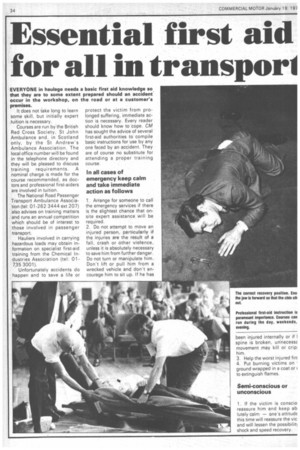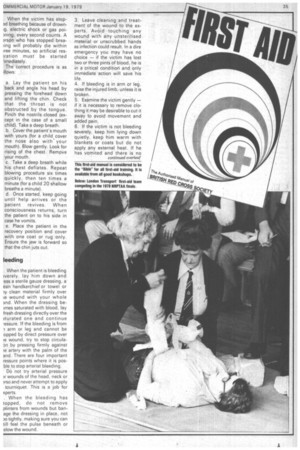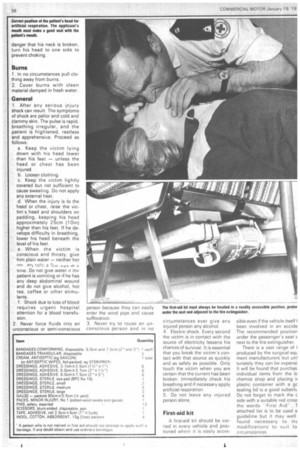Essential first aid for all in transpor1
Page 36

Page 37

Page 38

If you've noticed an error in this article please click here to report it so we can fix it.
EVERYONE in haulage needs a basic first aid knowledge so. that they are to some extent prepared should an accident occur in the workshop, on the road or at a customer's premises.
It does not take long to learn some skill, but initially expert tuition is necessary.
Courses are run by the British Red Cross Society, St John Ambulance and, in Scotland only, by the St Andrew's Ambulance Association. The local office number will be found in the telephone directory and they will be pleased to discuss training requirements. A nominal charge is made for the course recommended, as doctors and professional first-aiders are involved in tuition.
The National Road Passenger Transport Ambulance Association (WI: 01-2623444 ext 207) also advises on training matters and runs an annual competition which should be of interest to those involved in passenger transport.
Hauliers involved in carrying hazardous loads may obtain information on specialist first-aid training from the Chemical Industries Association (tel: 01735 3001).
Unfortunately accidents do happen and to save a life or protect the victim from prolonged suffering, immediate action is necessary. Every reader should know how to cope. CM has sought the advice of several first-aid authorities to compile basic instructions for use by any one faced by an accident. They are of course no substitute for attending a proper training course 1. Arrange for someone to call the emergency services if there is the slightest chance that onsite expert assistance will be required.
2. Do not attempt to move an injured person, particularly if the injuries are the result of a fall, crash or other violence, unless it is absolutely necessary to save him from further danger. Do not turn or manipulate him. Don't lift or pull him from a wrecked vehicle and don't encourage him to sit up. If he has been injured internally or if I spine is broken, unnecessz movement may kill or cripi him.
3. Help the worst injured firs 4. Put burning victims on • ground wrapped in a coat or to extinguish flames.
Semi-conscious or unconscious
1. If the victim is conscio reassure him and keep ab lutely calm — one's attitudE this time will reassure the vic and will lessen the possibilit) shock and speed recovery. • When the victim has stopad breathing because of drown electric shock or gas poiming, every second counts. A arson who has stopped breating will probably die within iree minutes, so artificial reslration must be started lmediately.
The correct procedure is as flows: a. Lay the patient on his back and angle his head by pressing the forehead down and lifting the chin. Check that the throat is not obstructed by the tongue. Pinch the nostrils closed (except in the case of a small child). Take a deep breath.
b. Cover the patient's mouth with yours (for a child. cover the nose also with your mouth). Blow gently. Look for rising of the chest. Remove your mouth.
c. Take a deep breath while his chest deflates. Repeat blowing procedure six times quickly, then ten times a minute (for a child 20 shallow breaths a minute).
d. Once started, keep going until help arrives or the patient revives. When consciousness returns, turn the patient on to his side in case he vomits.
e. Place the patient in the recovery position and cover with one coat or rug only. Ensure the jaw is forward so that the chin juts out.
leeding When the patient is bleeding iverely, lay him down and .ess a sterile gauze dressing, a ean handkerchief or towel or ly clean material firmly over ie wound with your whole 3nd. When the dressing be)rnes saturated with blood, lay fresh dressing directly over the iturated one and continue -essure. If the bleeding is from
arm or leg and cannot be opped by direct pressure over le wound, try to stop circulapn by pressing firmly against ie artery with the palm of the and. There are four important ressure points where it is posble to stop arterial bleeding.
Do not try arterial pressure )r wounds of the head, neck or oso and never attempt to apply tourniquet. This is a job for xperts.
. When the bleeding has topped, do not remove plinters from wounds but banage the dressing in place, not )o tightly, making sure you can till feel the pulse beneath or elow the wound. 3. Leave cleaning and treatment of the wound to the experts. Avoid touching any wound with any unsterilised material or unscrubbed hands as infection could result. In a dire emergency you may have no choice — if the victim has lost two or three pints of blood, he is in a critical condition and only immediate action will save his life.
4. If bleeding is in arm or leg, raise the injured limb, unless it is broken.
5. Examine the victim gently — if it is necessary to remove clothing it may be desirable to cut it away to avoid movement and added pain.
6. lithe victim is not bleeding severely, keep him lying down quietly, keep him warm with blankets or coats but do not apply any external heat. If he has vomited and there is no danger that his neck is broken, turn his head to one side to prevent choking.
Burns
1. In no circumstances pull clothing away from burns.
2. Cover burns with clean material damped in fresh water.
General 1. After any serious i,njury shock can result. The symptoms• of shock are pallor and cold and clammy skin. The pulse is rapid, breathing irregular, and the patient is frightened, restless and apprehensive. Proceed as follows:
a. Keep the victim lying down with his head lower than his feet — unless the head or chest has been injured.
b. Loosen clothing.
c. Keep the victim lightly covered but not sufficient to cause sweating. Do not apply any external heat.
d. When the injury is to the head or chest, raise the victim's head and shoulders on padding, keeping his head approximately 25cm (10in) higher than his feet. If he develops difficulty in breathing, lower his head beneath the level of his feet.
e. When the victim is conscious and thirsty, give him plain water — neither hot
ont .ery colf.:, di time. Do not give water it Impatient is vomiting or if he has any deep abdominal wound and do not give alcohol, hot tea, coffee or other stimulants.
f. Shock due to loss of blood requires urgent hospital attention for a blood transfusion.
2. Never force fluids into an unconscious or semi-conscious
person because they can easily The first-aid ku must always be located in a readily accessible enter the wind pipe and cause under the seal and adjacent to the lire extinguisher.
suffocation 3. Never try to rouse an unconscious person and in no circ.,umstances ever give any injured person any alcohol.
4. Electric shock. Every second 'the victim is in contact with the source of electricity lessens his chances of survival. It is essential that you break the victim's contact with that source as quickly and as safely as possible. Only touch the victim when you are certain that the current has been broken, Immediately check his breathing and if necessary apply. artificial respiration.
5. Do not leave any injured person alone.
First-aid kit A first-aid kit should be carried in every vehicle and positioned where it is easily acces sible even if the vehicle itself I been involved in an accide The recommended position under the passenger's seat 2 next to the fire extinguisher.
There is a vast range of I produced by the surgical eqL ment manufacturers hut uni tunately they can be expensi It will be found that purchas individual items from the le chemist shop and placing ii plastic container with a gc sealing lid is a good substitL Do not forget to mark the c side with a suitable red cross the words "First Aid". T attached list is to be used a guideline but it may well found necessary to ME modifications to suit lo
circumstances.




































































































